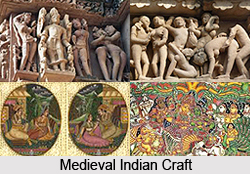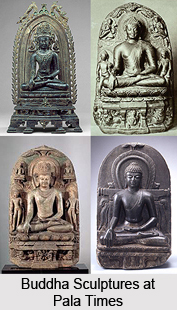 During the start of the medieval period of Indian history, after the Gupta dynasty, Indian artisans contributed a lot to uplift the Indian craft. This period in the history of Indian craft has been termed as the "Medieval Indian Craft". During this period, India was flourished with the abundance of several crafts as different dynasties enriched the Indian culture with different crafts to the Indian society and gradually those crafts got more polished and improved by the time span.
During the start of the medieval period of Indian history, after the Gupta dynasty, Indian artisans contributed a lot to uplift the Indian craft. This period in the history of Indian craft has been termed as the "Medieval Indian Craft". During this period, India was flourished with the abundance of several crafts as different dynasties enriched the Indian culture with different crafts to the Indian society and gradually those crafts got more polished and improved by the time span.
The craftsmen during this era under the Delhi Sultanate period flourished in the field of pottery, weaving, wood carving, metal working, jewellery etc.
Influence of Dynasties on the Medieval Indian Craft
The craft of each state in India reflect the influence of different empires. The Medieval Indian Craft witnessed a number of influential dynasties appearing and ameliorating the Indian craft. One of the influential dynasties that played the vital role in Indian craft was Chola dynasty that flourished in South India. The popularity of bronze metal in the Chola period was a continuation of the style and technique of the Andhra. One of the techniques that the Cholas patronized was the lost wax process, used for Indian bronzes. This indeed was one of the striking examples of the artistry of the Medieval Indian Craft.
 The contribution of the Cholas and the Vijayanagar Empire in the field of bronze craft, silk weaving, jewellery, temple carving is beyond parallel. A famous craftsmanship of Medieval Indian Craft was the great image of Shiva-Nataraja in his cosmic dance pose which not only symbolises the creation and destruction of the universe, but is considered a visual sermon of sorts by the devotees. The Chalukyan Empire had splendid instances of the craft on hard rock. This culture continued in the later dynasties like Rashtrakuta dynasty, Pallava dynasty etc.
The contribution of the Cholas and the Vijayanagar Empire in the field of bronze craft, silk weaving, jewellery, temple carving is beyond parallel. A famous craftsmanship of Medieval Indian Craft was the great image of Shiva-Nataraja in his cosmic dance pose which not only symbolises the creation and destruction of the universe, but is considered a visual sermon of sorts by the devotees. The Chalukyan Empire had splendid instances of the craft on hard rock. This culture continued in the later dynasties like Rashtrakuta dynasty, Pallava dynasty etc.
Buddhist Influence on Medieval Indian Craft
During the 9th century, in the Pala-Sena period, Buddhism added a whole new facet to the medieval Indian craft. The excellent metal craft of this era, done in the North Indian style, were the luxuriant instances of artistry. The efficient craftsmen of this era blended the native style, the traditional Hindu techniques and Islamic conception of motifs and gave rise to a fusion form of craft.
Islamic Influence on Medieval Indian Craft
Moreover, orientalism came to India with the advent of Muslims. Before the arrival of Mughals in the 16th century, several Muslim invaders including Mahmud of Ghazni, the Tughlaqs, the Sharqis and the Lodhis, briefly appeared on the Indian historical scene and impressed on the art of that time.
In the early 16th Century, Mughal art synthesised Turko-Mongolic, Persian, European, and Indian traditions. These amalgamated styles further enriched the medieval Indian craft. The time of Akbar was the "Golden Time" in the history of Medieval Indian Craft. Craft was given the freedom and considered as distinct art form. This age encouraged the introductions of European realism and allowed the amalgamation of Persian decorativeness and Rajasthani liveliness with the European style. This age gives ample instances of marble carvings, the use of which was popularised by the Mughals.
 Techniques Applied on the Medieval Indian Craft
Techniques Applied on the Medieval Indian Craft
During the medieval era, new techniques like inlay work; glass engraving, carpet weaving, brocades, enamelling etc were introduced in Indian. The famous Peacock Throne of the Mughals is one of the finest examples of gem inlay work and metal craft. This dynasty promoted the creation of enamelled jewellery and a host of other craft traditions. The royal clans of this era enabled the craftsmen to take the Indian craft to an unprecedented height. Along with this promotion and development of jewel craft was also paid due heed. India, thus, developed as a major source and trading centre for precious stones and intricate jewellery designs. Some of the most appraised jewellery craft of Mughal era were Bidriware and Meenakari craft.
Bidriware: Bidriware is valued for its fine craftsmanship. Its sleek and smooth dark coloured metal work with intricate eye-catching designs on its glossy surface is famous all over the world.
Meenakari: Another craft which is the Meenakari craft, is the continuation of the art of enamelling or fixing colour by melting in fire which had been practised in India ever since the ancient times.
The medieval period introduced many techniques for colouring ornaments and other objects of gold and silver and also other metallic objects made of copper, brass etc. Jaipur was most famous for enamelling work on gold, followed by Varanasi, Alwar and Delhi, Multan, Shang and Kangra; whilst Bahawalpur, Kashmir, Kulu etc. had traditions of enamelling on silver. Throughout centuries, crafts have been embedded as a culture and tradition within rural communities.
With the demolition of the Mughal dynasty, the medieval period ends. The post Mughal era introduces colonial rule, the reign of the British. The initiation of the colonial period ensured the establishment of the modern or contemporary era that ushered the Western influences on the Indian craft.






